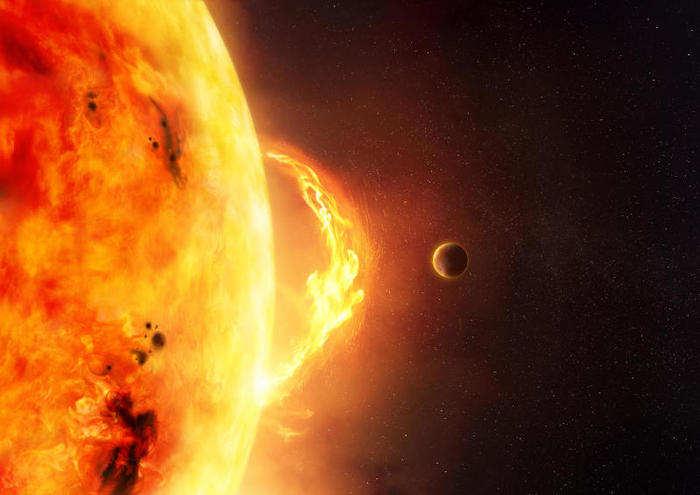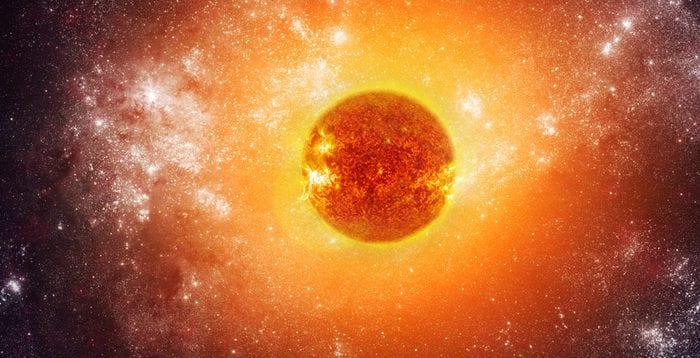The Sun - the star of our system - which is called Solar for a reason, is the main source of life on Earth: without it, we could not exist! But it's not just life that carries this bright light in the sky. If it were not for our planet's atmosphere, a long and painful death would await us.
Over the past centuries - physicists, astronomers and scientists have discovered and learned a lot, but even more is still unclear to us. That's why NASA has sent the Parker Solar Probe, a space probe that will reach the solar corona - the outermost part of the star - in 2024 to provide us with useful information about the mysterious solar winds.
The Parker Solar Probe has already made history: this man-made object reached its closest distance to the Sun in November 2018, flying 40 million kilometres. At the end of its journey, it will be very close "only" 6 million kilometres will separate it from the star.
But what does the Sun look like? It has no boundaries because it is made up of gas.

We think of our Sun as just a hot, bright spot in the sky that can sometimes be very annoying... but no, it is restless and changing every hour, every minute, every second! There are gigantic explosions in the solar corona, with the power of over 500 million atomic bombs. How are these processes triggered? We can't learn anything from the Earth, it's like trying to understand how an engine works by looking at its exhaust. We have to go there and see... that's why a space probe was sent.
After all, it is a sort of rotating ball of plasma, consisting mainly of hydrogen and helium. The Earth, and all the other planets in the solar system, are trapped in its outer atmosphere, called the heliosphere. From this sphere emanates a supersonic wind, a glowing bubble of gas and electrified particles that travels through interstellar space at nearly 800 kilometres per second. Other than that, we know almost nothing about the solar wind: neither how it arises nor how it reaches such superspeed. There are still a lot of mysteries...
Yes, the Sun is our source of light and heat which is formed by the fusion of hydrogen atomic nuclei. This nuclear reaction produces helium atoms and this will continue until our star uses up all the hydrogen it contains (about 92% of its total volume; the remaining 8% consists of helium and other elements). But don't worry: hydrogen will not run out for another 4 to 5 billion years!


The sun and the main characteristics of the star.
Nucleus: The core takes up barely a hundredth of the Sun's total volume, but accounts for about a third of its mass. This is where nuclear fusion reactions take place: Temperature: 15,000,000°C.
RADIOACTIVE ZONE: This is the area through which photons transfer the energy produced in the nucleus. Because of its enormous density, photons are constantly being emitted and absorbed. Temperature: 7 000 000 °C
CONVECTIVE ZONE: extends from the base of the photosphere about a quarter of the distance from the centre of the Sun. Thermal energy is carried to the surface of our star by gaseous currents.
PHOTOSPHERE: The visible surface of the Sun, a boiling ocean of gas in a state of plasma. Its energy leaves the Sun in the form of light.
ATMOSPHERA: The solar atmosphere is above the photosphere. From the atmosphere, energy emanating from the core sometimes looks for many thousands of years to leave the Sun and disperse into space.
CHROMOSPHERA: This layer is above the 5,000 km thick photosphere, with temperatures ranging from about 4,500 to 100,000 °C.
CORONA: It is above the chromosphere and extends millions of kilometres into space. The temperature of the corona reaches one million °C.
solar MAKES: this is the dark region of the photosphere. they look like this because they are colder than the surrounding areas: around 4,000 °C
Another mystery scientists want to solve. This is the question of different temperatures: the deepest part of the Sun, where nuclear fusion reactions take place (four hydrogen atoms combine to form a helium atom), reaches an astounding temperature of 15 million degrees; the photosphere (i.e. the part that we can see) is much colder, less than 6 thousand degrees. Further into the solar corona, however, the temperature rises again and, depending on the region, is between two and 10 million degrees: how is this possible, given that the heat source is in the centre? And where does all this energy come from?
Apart from that, we still don't know how to predict 'solar magnetic storms'. Today, all we know is that the motion of the gases that make up the Sun produces magnetic fields that arise from within the photosphere. To us they look like spots; they form over an 11-year cycle and change over time. Sometimes there are big flares, like someone lighting a mighty beacon in a certain place on the Sun, so solar matter eruptions occur. If these outbursts occur in the direction of the Earth, there is a danger of great trouble.
Our planet has a strong shield against solar and cosmic particles, which has been created by the Earth's magnetic field. But it is weaker at the poles, and the Sun's powerful radiation penetrates them and releases energy into the upper layers of our atmosphere. This is how auroras are created.
In addition, "our satellites, power plants, power distribution networks and electronic devices could be damaged and even rendered inoperable.

MAN AND THE SUN
The sun has always fascinated us. Perhaps because our lives depend on this small star (there are much bigger and more powerful ones in the galaxy).
Evidence of this can be seen in the megaliths built in prehistoric times, from the Neolithic to the Bronze Age. They are imposing rock pillars, like those found at Stonehenge in the UK. But what were they used for?
Around 11,000 years ago, when agriculture was developing, people began to realise that the cycle of plants depended on the sun and that they should sow at exactly the right time. But there was no calendar or writing system at the time: how could they do this? The ancients knew that the points of sunrise and sunset change throughout the year and reach two extreme points during the winter and summer solstices, then change direction and go back. So one way was to set up two poles pointing towards one of these extremes and use them as a viewfinder. Imagine being a farmer: to know when to sow, you simply count down the days from when the sun rises at that point. This is why megaliths, such as Stonehenge, are often oriented towards the solstice.
Our star also played an important role for the pyramids. These grandiose structures are oriented according to the cardinal points which in ancient times could be determined when the Sun was at equinoxes. But for the ancient Egyptians, stars such as Sirius and Orion's belt were also important. That is why in some of the pyramids the narrow passages seem to point directly towards them or to the constellation of Lesser Ursa".
In short, now that we are studying the Sun more and more, our connection with it is even stronger. Perhaps because, as the great astronomer recalled Margarita Huckwe are made of the same material as stars.


 and then
and then 
